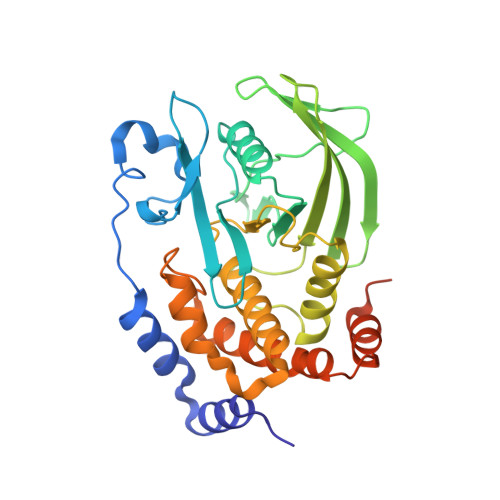Covalent Allosteric Inactivation of Protein Tyrosine Phosphatase 1B (PTP1B) by an Inhibitor-Electrophile Conjugate.
Punthasee, P., Laciak, A.R., Cummings, A.H., Ruddraraju, K.V., Lewis, S.M., Hillebrand, R., Singh, H., Tanner, J.J., Gates, K.S.(2017) Biochemistry 56: 2051-2060
- PubMed: 28345882
- DOI: https://doi.org/10.1021/acs.biochem.7b00151
- Primary Citation of Related Structures:
5T19 - PubMed Abstract:
Protein tyrosine phosphatase 1B (PTP1B) is a validated drug target, but it has proven difficult to develop medicinally useful, reversible inhibitors of this enzyme. Here we explored covalent strategies for the inactivation of PTP1B using a conjugate composed of an active site-directed 5-aryl-1,2,5-thiadiazolidin-3-one 1,1-dioxide inhibitor connected via a short linker to an electrophilic α-bromoacetamide moiety. Inhibitor-electrophile conjugate 5a caused time-dependent loss of PTP1B activity consistent with a covalent inactivation mechanism. The inactivation occurred with a second-order rate constant of (1.7 ± 0.3) × 10 2 M -1 min -1 . Mass spectrometric analysis of the inactivated enzyme indicated that the primary site of modification was C121, a residue distant from the active site. Previous work provided evidence that covalent modification of the allosteric residue C121 can cause inactivation of PTP1B [Hansen, S. K., Cancilla, M. T., Shiau, T. P., Kung, J., Chen, T., and Erlanson, D. A. (2005) Biochemistry 44, 7704-7712]. Overall, our results are consistent with an unusual enzyme inactivation process in which noncovalent binding of the inhibitor-electrophile conjugate to the active site of PTP1B protects the nucleophilic catalytic C215 residue from covalent modification, thus allowing inactivation of the enzyme via selective modification of allosteric residue C121.
- Department of Chemistry, University of Missouri , 125 Chemistry Building, Columbia, Missouri 65211, United States.
Organizational Affiliation:



















